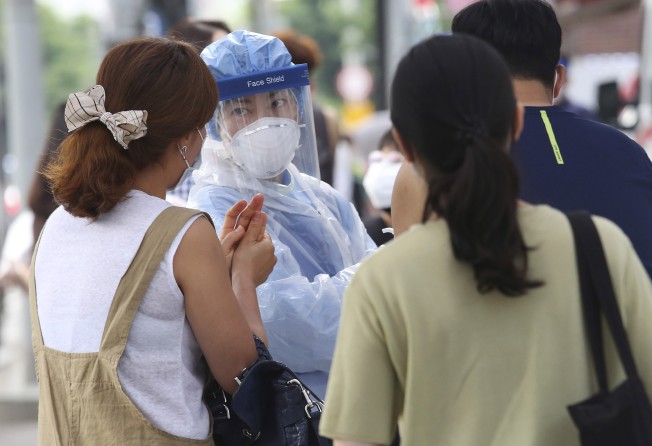Coronavirus: South Korea’s surge raises prospect of stricter curbs
- South Korea, once regarded as a success story in containing the virus, has recorded almost 4,000 new cases in the past two weeks
- Parliament was shut down and lawmakers went into self- quarantine on Thursday as the nation reported its largest daily increase in cases since March

South Korea has reported 441 new coronavirus cases, the largest daily increase since March 7, when the country experienced its first major outbreak.
Of the new cases, 434 were locally transmitted, prompting authorities to consider increasing restrictions beyond current social distancing rules.
“The virus is spreading across the country including the metropolitan area and other provincial cities with increasing intensity and at various facilities,” Yoon Tae-ho, a senior health ministry official, said on Thursday.
Heath officials have lamented that people have continued going out in public, noting that transport activity in the Seoul area declined by only 20 per cent last weekend.
On Thursday, the government urged businesses to have employees work from home.
The recent surge in cases has placed the country’s health care system under additional strain. Exhausted staff have been stretched to their limit and some medical facilities have been closed after employees or patients tested positive.
South Korea adopted a three-tiered distancing system in June and on Sunday imposed level two restrictions, which were already in place in Seoul and Busan, across the rest of the country. The government now faces increased pressure to implement level three restrictions.
“If we fail to flatten this curve this week, we have to shift into level three. In that case, social and economic damage will be enormous,” said Jeong Eun-kyeong, director of the Korea Centres for Disease Control and Prevention (KCDC).
Under level two restrictions, indoor gatherings of 50 or more and outdoor gatherings of 100 or more outdoors have been prohibited. “High-risk” facilities such as bars and buffet restaurants have been closed. Level three restrictions would prohibit meetings of 10 or more people and empower authorities to limit opening hours for shops.
Such steps would allow only essential economic and social activities to continue and could significantly damage an already weakened economy, officials said. South Korea’s central bank on Thursday lowered its growth outlook for the national economy this year, predicting it to shrink by 1.3 per cent. The country’s economy last posted a contraction in 1998, during a crippling foreign currency crisis.
South Korea’s parliament was shut down on Thursday and a group of lawmakers were in self-quarantine after a photographer who covered a ruling party meeting on Wednesday tested positive.
Officials held late-night talks on how to handle the situation and ordered all parliamentary activities suspended from Thursday, with both the assembly and a building housing lawmakers’ offices closed. Opposition parties also cancelled scheduled meetings.
The photographer came in contact with about 50 people at the assembly on Wednesday, 32 of them party lawmakers and officials.
The parliamentary shutdown is the second over coronavirus concerns, after a February closure when an attendee at an event tested positive.
South Korea, once regarded as a success story in its efforts to contain the coronavirus, has recorded almost 4,000 new cases in the past two weeks. Many of those cases have been traced to the Sarang Jeil church in northern Seoul and an August 15 anti-government rally attended by the church’s followers and right-wing activists.
Professor Lee Wang-jun at Myongji Hospital said daily increases could surpass 1,000 as the virus has been “spreading far and wide”.
“We have to don face masks at least until the end of next year,” he said, adding that vaccines may work for only half the population.
Additional reporting by Reuters, Agence France-Presse, Associated Press